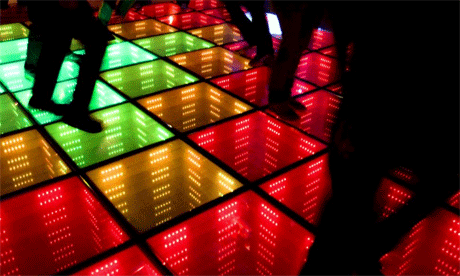
Power harvesting is already being tested on disco dancefloors. Photograph: EPA
The beating of a patient's heart, the shudder of a tube train and the pounding of thousands of commuters' feet on crowded platforms are being exploited as new sources of power.
Engineers and scientists are developing tiny generators that turn the kinetic energy of everyday movements into electricity which can then power sensors or provide electricity for remote installations.
The technology, known as power harvesting, is already being tested in helicopter frames, the floors of discos and in volunteers' knee joints in order to generate electricity. In the near future, harvesters could be used to recharge iPods and mobile phones, say researchers.
'The idea is a not a new one,' admitted Dr Steve Beeby, of Southampton University. 'Self-winding watches are fitted with devices like these to recharge their batteries so they don't have to be replaced all the time. However, the latest versions are far more sophisticated and will have a much greater impact on everyday life.'
Beeby has fitted harvesters at oil refineries. Vibrations from pipes and pumps drive the devices which in turn generate electricity for sensors. These sensors provide data that show if the refinery is operating safely and effectively.
'Without these devices we would have to link our sensors with miles of cables: a hazard and a waste of money,' added Beeby who is now working on fitting power harvesters to the frames of aircraft so embedded sensors can provide data readings about metal stress.
Power harvesters are also being developed to help cardiac patients. At Imperial College, London, Dr Paul Mitcheson is working on a pacemaker that is kept constantly charged by the beating of a person's heart. Such a device, he said, could mean that pacemaker replacement operations - which are typically carried out every six or seven years - might become a thing of the past.
The idea of using human energy to power electronic devices was originally developed by Trevor Baylis for his wind-up radio more than a decade ago. Modern versions are becoming more sophisticated, however. Even the gyrations of dancers are being used to generate power at the Bar Surya in London. Crystalline harvesters under its disco floor create tiny pulses of energy each time a dancer pushes down. The electricity created this way is used to offset the bar's utility bills.
Installed on a large scale, in tube and rail stations, these underfloor harvesters could provide a considerable output of electricity. UK and US military researchers are exploring the potential of energy-harvesters that could be built into soldiers' boots to provide precious power in remote and dangerous settings.P



No comments:
Post a Comment